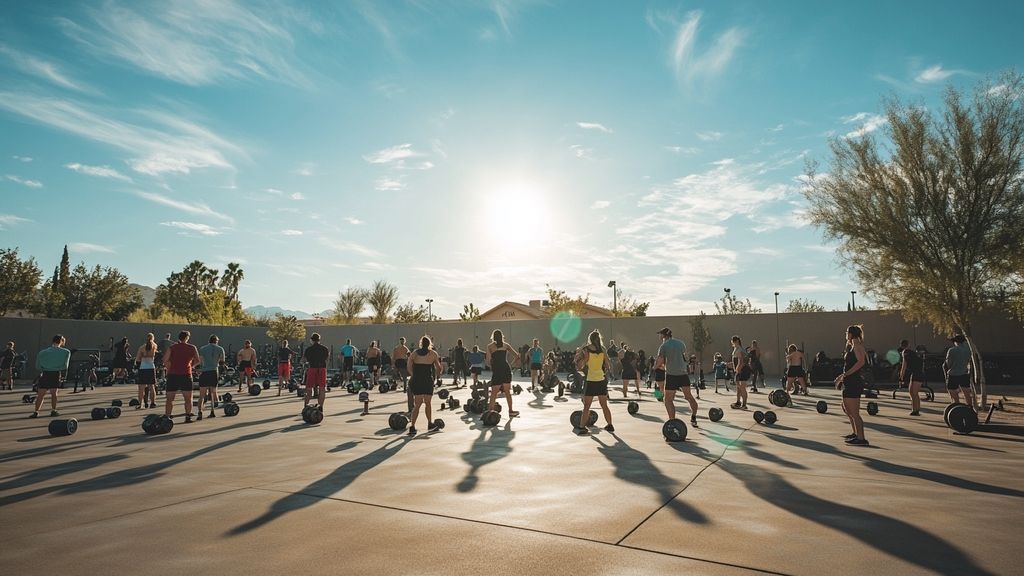CrossFit represents more than just a type of workout; it embodies a revolution in the fitness culture that has taken the world by storm. It was established by Greg Glassman and Lauren Jenai in 2000, combining elements of gymnastics, weightlifting, and high-intensity interval training (HIIT). Over the years, CrossFit has transformed how individuals perceive fitness, moving away from traditional methods to a more inclusive and community-driven approach.
With its rapid growth, CrossFit has become a global phenomenon, attracting diverse participants ranging from elite athletes to casual gym-goers. This extensive adaptation has prompted not just physical transformation but also significant social changes within fitness communities.
The Birth of CrossFit
The inception of CrossFit can be traced back to its founders, Greg Glassman and Lauren Jenai. They launched the first CrossFit gym, often referred to as a ‘box’, in Santa Cruz, California. Unlike traditional gyms, where machines fill the space, CrossFit boxes emphasize functional movements, varied workouts, and a communal atmosphere. In this setup, the focus shifted towards developing versatile athletes, capable of tackling any physical activity they might encounter.
CrossFit workouts are typically short bursts of high-intensity training lasting about 20 minutes, combining strength exercises, cardio, and agility drills. The methodology encourages individuals to push their limits, fostering a supportive environment where members cheer each other on.
CrossFit’s Unique Approach
At its core, CrossFit promotes the philosophy of ‘community-based fitness.’ Participants engage in workouts together, providing a sense of camaraderie that many traditional fitness regimens lack. This environment encourages individuals to break social barriers and foster friendships born from shared sweat and struggles.
The community focus has been instrumental in the popularity surge of CrossFit. Members identify not just with their local box, but also with the global CrossFit community. People gain pride from their achievements, whether it’s completing a tough WOD (Workout of the Day) or participating in CrossFit Games.
Moreover, the emphasis on teamwork and support aids in building mental resilience. The high-pressure environment and the need to perform often lead to breakthroughs in personal limitations, both physically and mentally. CrossFit showcases that fitness is as much about personal growth as it is about physical appearance.
CrossFit and Health Trends

The rise of CrossFit paralleled a noteworthy shift in how society approached health and fitness. In the late 1990s and early 2000s, America faced escalating health crises. Unhealthy habits coexisted with a decline in social interactions and community involvement. Eric C. Stevens highlighted this trend, outlining how as our ‘social capital’ plummeted, so did our overall health.
With this backdrop, CrossFit emerged as a beacon of hope. Its emphasis on collective participation rekindled a sense of belonging among fitness enthusiasts. People began to view fitness as more than a personal endeavor, but as a shared journey.
Building Resilience and Strength
One of the pivotal aspects of CrossFit is its ability to foster resilience, both physically and mentally. The challenges presented in workouts not only test strength but also enhance endurance and grit. Many members recount personal stories of their fitness journeys, where they faced challenges that extended beyond the gym.
CrossFit builds a culture of overcoming adversity. Whether through mastering an Olympic lift or completing a grueling bodyweight workout, participants learn that consistency and effort yield results. This aspect of CrossFit contributes significantly to personal empowerment, enabling individuals to tackle challenges in all areas of their lives.
Moreover, the community aspect amplifies this resilience. Witnessing peers’ successes and struggles creates an environment where individuals feel comfortable sharing failures and victories alike. Thus, every member, regardless of skill level, plays a vital role in the culture.
The Expansion of CrossFit
The reach of CrossFit has extended far beyond its original locations in California. Today, there are thousands of affiliate gyms around the world, making it a truly global phenomenon. Each gym maintains its unique flavor but adheres to the core principles of CrossFit.
With this expansion, numerous businesses have emerged to cater to the CrossFit community. Equipment manufacturers, nutrition companies, and apparel brands have all found a market in the burgeoning world of CrossFit. Rogue Fitness, based in Ohio, emerged to meet the overwhelming demand for specialized workout equipment.
The Role of Competition
Competition is ingrained in CrossFit’s identity, exemplified by the CrossFit Games, an annual athletic competition that crowns the ‘Fittest on Earth.’ These games not only showcase elite athletes but also motivate everyday participants to challenge themselves. Learning from top athletes and watching their dedication can inspire anyone to push further.
The camaraderie found in competitive settings is palpable. Participants cheer for one another and celebrate victories together, binding the community while igniting aspirations. Many individuals who initially participated for personal fitness find themselves captivated by the competitive aspects of CrossFit.
CrossFit also emphasizes scalability. Regardless of fitness level, everyone can participate in a competition. Workouts can be modified, making the sport accessible while still testing participants appropriately. This inclusivity embodies the spirit of CrossFit, welcoming every athlete.
The Cultural Shift in Fitness

CrossFit represents a pivotal change in how society views fitness culture. No longer is it merely about aesthetics; it intertwines with themes of community, resilience, and self-improvement. Individuals share their journeys, uplift each other during workouts, and create lasting friendships.
Moreover, the growth of social media has played a role in shaping how fitness communities evolve. Platforms allow athletes to share achievements, cooking tips, and workout routines, further enhancing the sense of belonging. The visual impact of CrossFit is undeniable, with numerous accounts showcasing physical transformations alongside emotional journeys.
Embracing Inclusiveness
The heart of CrossFit lies in its inclusiveness. Regardless of age, experience, or physical ability, everyone finds a place within its community. This nurturing environment is essential to developing self-confidence and reinforcing individual capacities.
Moreover, many CrossFit gyms incorporate programs tailored for different demographics, such as teenagers, seniors, and those with physical limitations. These initiatives broaden the appeal of CrossFit, positioning it as an adaptable fitness avenue where the focus is on individual growth and achievement.
Celebrating diversity and inclusion, CrossFit helps break down stereotypes around fitness. The varied backgrounds of members contribute to a richer community experience, fostering personal connections among participants.
CrossFit’s Future in Fitness
As CrossFit continues to evolve, its impact on fitness culture will likely deepen. The significance of community-driven approaches promotes healthier lifestyles and champions inclusivity. For many, CrossFit is not just a workout regimen; it has become a way of life.
Looking ahead, CrossFit will remain a core player in the fitness industry, blending its traditional roots with modern innovations. The incorporation of technology, personalized training programs, and nutrition guidance will enhance the experience for participants, resonating with an increasingly diverse audience.
Final Thoughts on CrossFit’s Impact
In summary, the establishment of CrossFit by Greg Glassman and Lauren Jenai revolutionized the fitness landscape by shifting focus to community, resilience, and inclusivity. Athletes engaged in this methodology experience profound personal growth alongside physical transformation.
As CrossFit spreads globally, it forms an integral part of societal well-being, emphasizing that fitness transcends mere appearance—it’s about fostering a sense of belonging and shared experience. The evolution of fitness culture showcases that everyone can be a part of this journey toward optimal health and wellness.
